Looking for a comprehensive Hubstaff vs Time Doctor comparison?
Tracking actual hours worked by your employees — whether they’re in-house workers or a remote team, can cause a real headache.
An excellent time tracking tool can make the entire process relatively smoother, faster, and effective.
So which one do you choose?
While there are tons of options out there, we will compare two of the best time tracking tools on the market, Hubstaff vs Time Doctor, in this post.
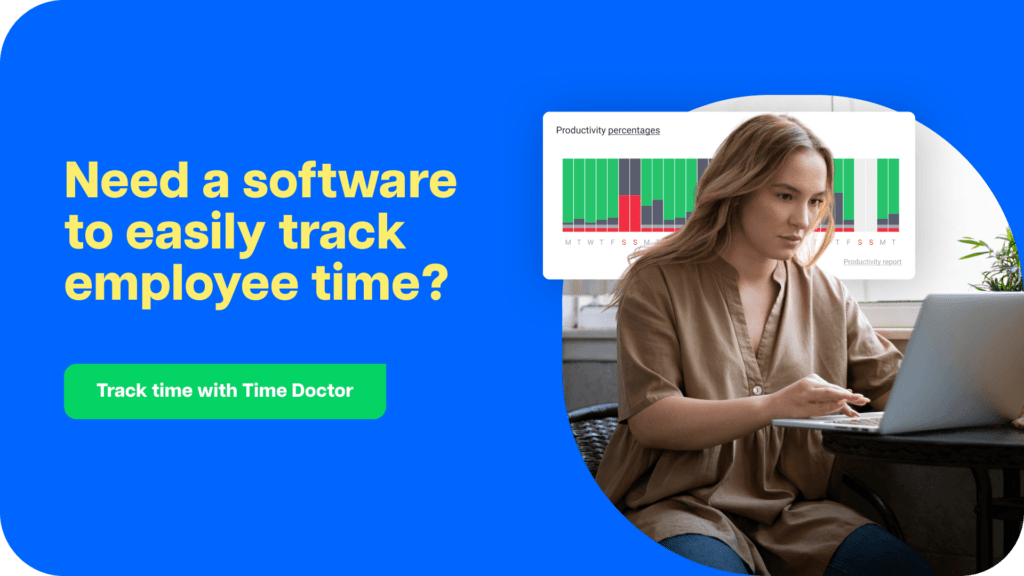
Table of Contents
- What is Hubstaff?
- What is Time Doctor?
- Hubstaff vs Time Doctor comparison
- Hubstaff vs Time Doctor: Final verdict
Let’s dive in.
What is Hubstaff?
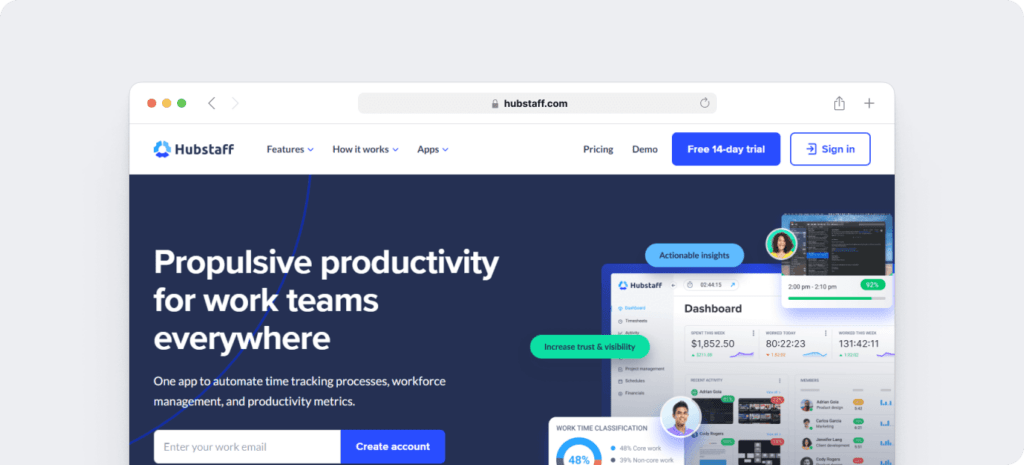
Hubstaff is a great productivity management and time tracking app that helps employees and organizations track time and increase efficiency.
Hubstaff’s smart employee time tracking software lets you automatically track how much time is spent on projects and tasks during work hours.
With Hubstaff, you can:
- Track time and gain insights about time wastage.
- Monitor what employees work with screenshots.
- Process employee payroll and invoice clients.
- Generate detailed reports and accurate online timesheets.
What is Time Doctor?

Time Doctor is a powerful productivity management and time tracking solution used by large organizations and small businesses to boost both in-house and remote team productivity.
Time Doctor is easily scalable, which makes it an excellent tool for any enterprise and even freelancers.
With Time Doctor, you can:
- Track time taken for each task or project accurately.
- Generate powerful reports to identify productivity issues so you can make improvements.
- Track website usage to see which websites your employees are using at work
- Automatically process payroll and client billing.
- Sync data with popular time and project management software like Jira, Basecamp, Zoho Projects, Trello, and Asana.
Hubstaff vs Time Doctor comparison
Here’s a feature by feature comparison to help you decide which tool — Time Doctor or Hubstaff — offers the best value for money.
Let’s look at what each of these tools has to offer:
1. Time tracking
Here’s how both Hubstaff and Time Doctor track time spent on tasks or projects:
1) The Hubstaff approach
A. Automatic Time Tracking
Hubstaff has to be first installed on a user’s home computer or laptop on which they’re working.
After logging in, you are presented with two options: “Me” or “Team.”
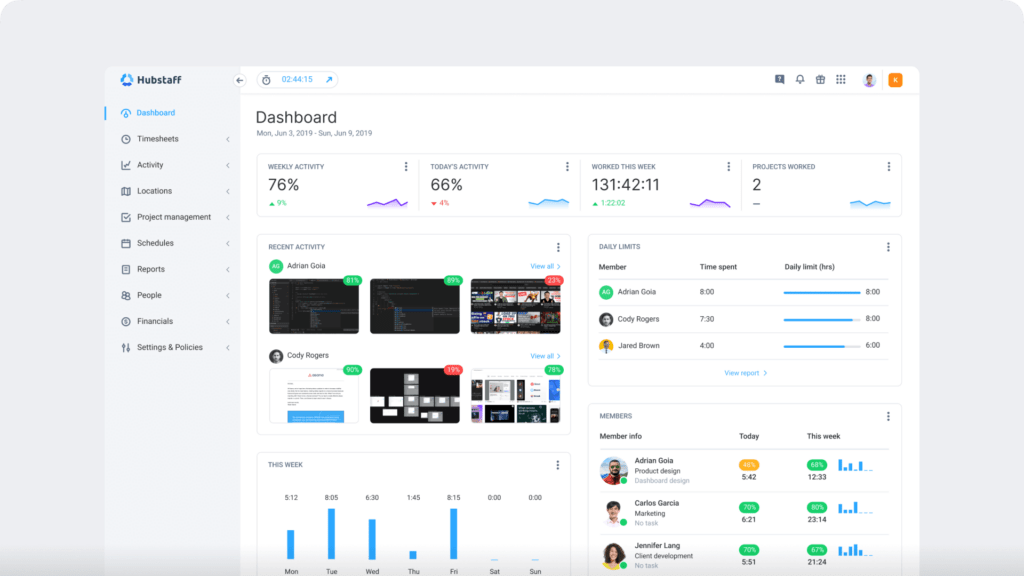
Here’s the information you’ll see if you select the “Me” dashboard:
- The total hours worked for a day.
- The total hours worked for the week, including an activity percentage.
If you select the “Team” dashboard, you’ll see the same information but for the entire team.
You can also see:
- Who’s online.
- Their activity levels.
- A bar graph showing how many hours they worked that week.
From here, you can also view timesheets — to see how much an employee has worked on a particular project, as well as their activity levels.
You can also select projects, where instead of individual members, the time spent on each project is displayed. This helps you see which tasks are taking more time and can be improved.
B. Activity levels
Now coming to the real deal: the activity levels and how they track your productivity.
Hubstaff detects if there is movement in your keyboard or mouse and tags these minutes as active and the rest of it as inactive. It then generates reports for set time intervals.
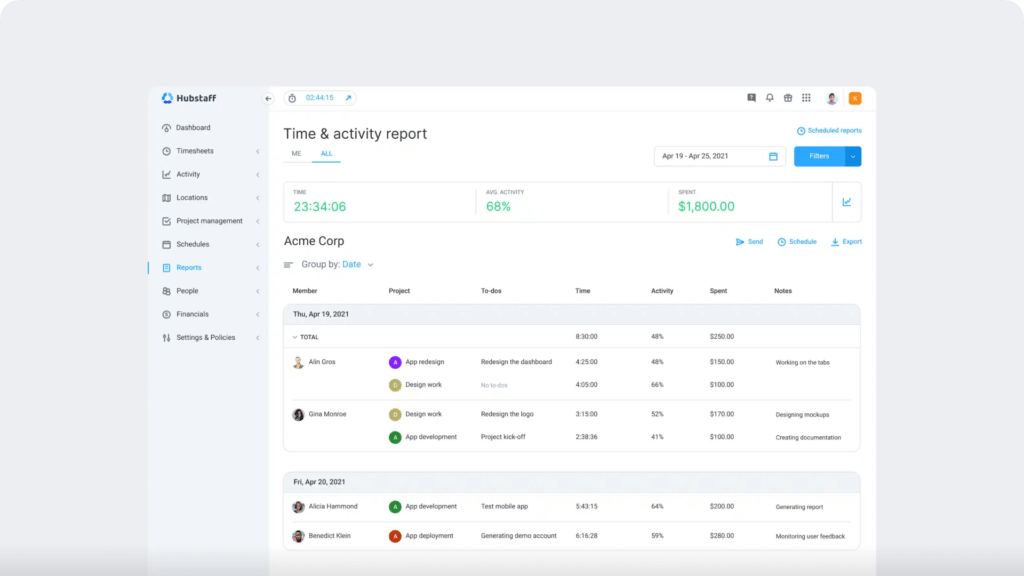
Need an example?
Here’s how 100 seconds at my workplace typically looks like:
- 30 seconds researching on the post that I’m writing.
- 20 seconds browsing images to use in the post.
- 30 seconds actually writing the post.
- 20 seconds of brushing my hair out of my eye and staring into space (no mouse or keyboard used).
So my activity level is 80% since I’m using 80 seconds of the 100 seconds using the keyboard or mouse.
You get time reports for all your activities and the percentage of time that you actually spend on various tasks to help with time management.
As handy as it’s, activity levels can’t accurately tell if one employee was working harder than another.
For example, if you have a developer on your team who spends more time coding, then they will have a higher keyboard usage, and in turn, a higher activity level than, say, a content writer who spends more time reading and researching.
Does this mean the writer was working less?
Definitely not.
Hubstaff clarifies that the activity levels should only be used as “trends” to see if you can make minor corrections as and when needed.
2) The Time Doctor approach
A. Interactive time tracking
How does Time Doctor do it?
Time Doctor uses a whole different way of approaching this problem and gives users a lot more freedom to track time while they’re working.
Similar to Hubstaff, you have to download the desktop app.
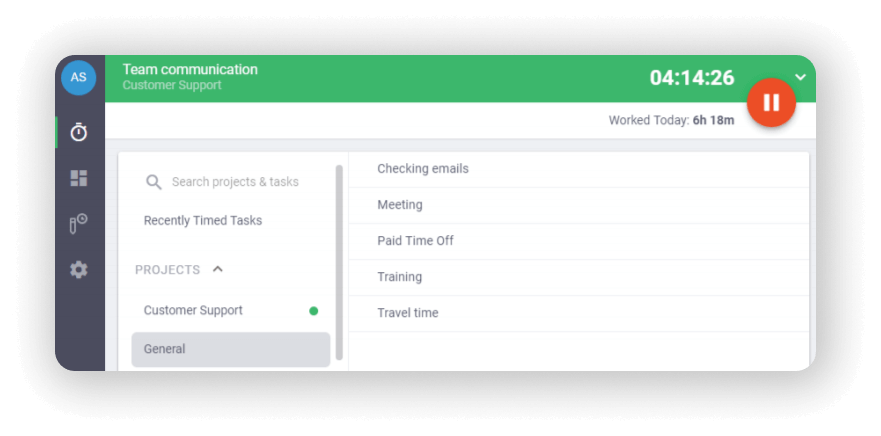
After downloading Time Doctor, here’s how to track time:
- Click on the desktop icon and log in to the tool.
- Create the task/tasks that you are working on.
- You’ll see a start and stop timer next to your task.
- Click on the play button to start and stop recording time.
Time Doctor will log how many minutes or hours you have spent on a particular task.
Managers have an option of creating tasks that can be assigned to employees, so all they have to do is click the little play button.
The interface is really user-friendly, and you can figure it out in a few minutes.
So the onus is on the user to set tasks for the day, and then a handy little bar appears on your screen, showing time being tracked.
You can now start your work, and the app tracks what websites you visit and what apps you were using in this period.
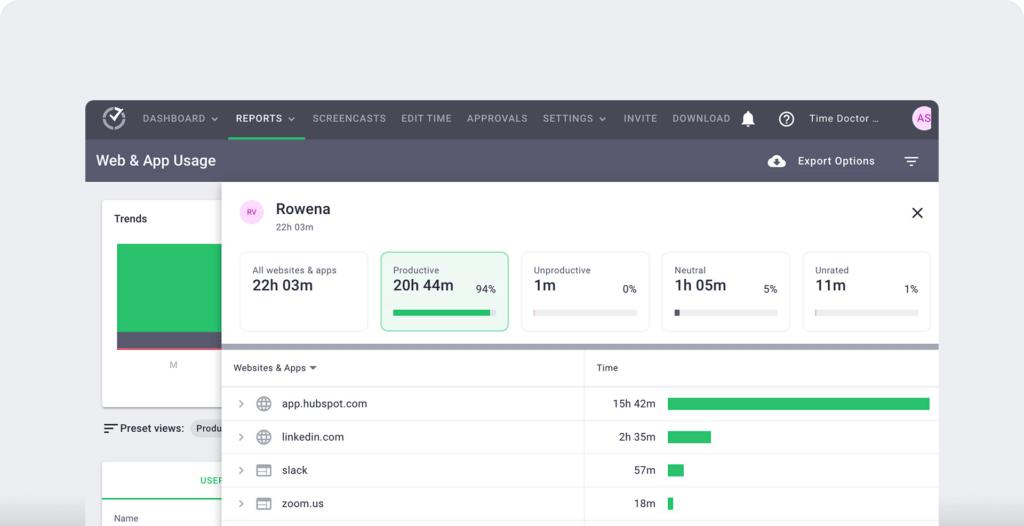
The manager can then view detailed analytics by extracting reports, like the one above, to see what task the employee was working on and for which team.
B. Idle time pop-ups
Time Doctor also blows the activity levels feature of Hubstaff out of the water.
How?
With Time Doctor, a manager can specify how long his employee can go without a keystroke or mouse movement.
If the limit exceeds, then bam!
A pop-up appears asking what the employee is up to.
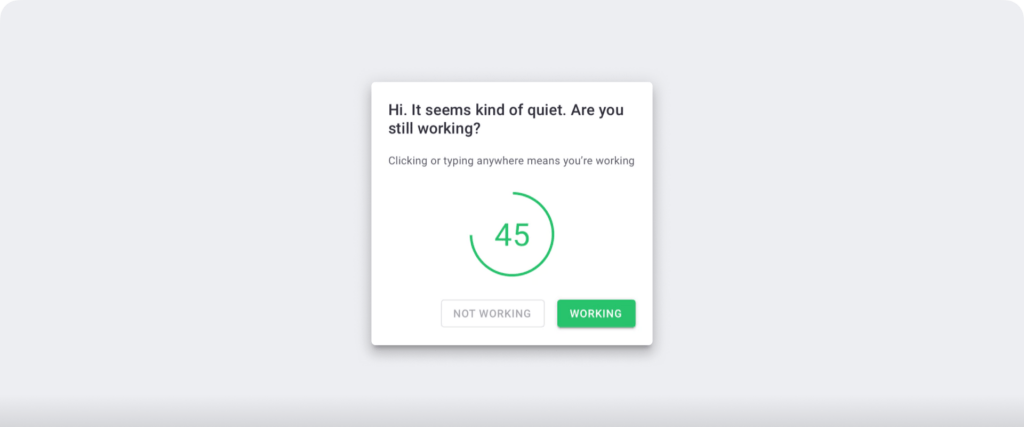
Prolonged idle time and the employee is automatically put on a “break.”
So you can’t trick the system, telling you were working while you were actually playing video games.
While an idle time feature is available on Hubstaff too, configuring it is a tad more complicated.
Time Doctor also sends detailed reports of websites that an employee visits during the time they log in, making employees more accountable to review their own productive time.
Quick recap
Hubstaff has an activity tracking feature that’s neat and does the basic task of measuring keyboard and mouse activity levels. On the other hand, Time Doctor lets you create tasks and then track the actual time you spent on these tasks. Time Doctor also has features to ensure that employees don’t falsify records.
2. Employee monitoring
Nobody likes their managers standing behind them staring at their screens as they type, which is why both managers and employees can benefit from employee monitoring software.
Both Time Doctor and Hubstaff help monitor employee activities in a non-intrusive manner.
1) The Hubstaff approach
A. Screenshots
The Hubstaff employee monitoring feature lets you see what each team member is working on in real-time.
How?
Hubstaff can take randomized screenshots of each employee’s work screen.
The project manager or employer can set the feature to take a screenshot once, twice, or three times per ten seconds. You can also choose to turn it off if you don’t want screenshots.
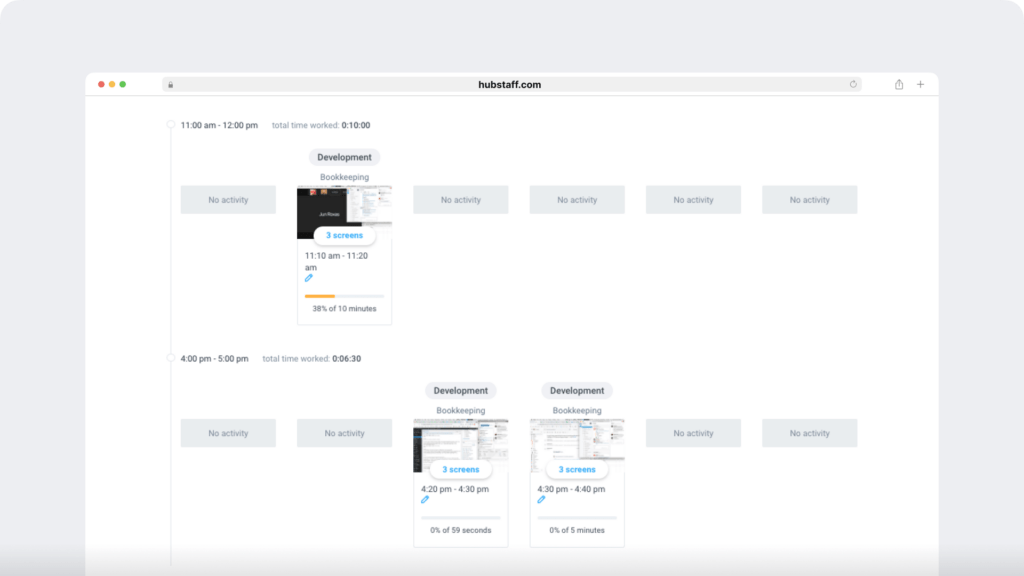
B.Web and app tracking
Sure, you know what your employees’ screen looked like when they were claiming to be working. But how do you know which sites or apps they used during those hours?
This is where web and app tracking comes in.
Hubstaff tracks the URLs that an employee visits and presents them on a screen which looks like this:
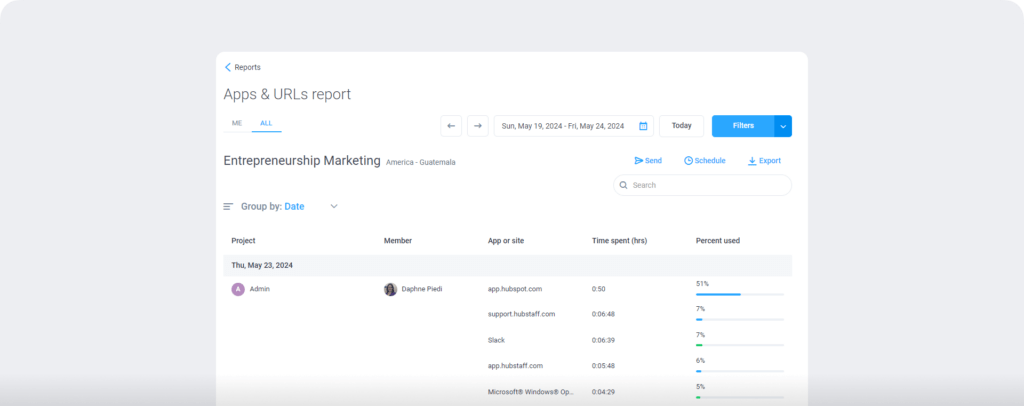
You can see the time spent on a website, the percentage of total use, and a small bar for visualization.
You also get another report that logs how much time an employee is using a particular app, which looks pretty similar to the website report:
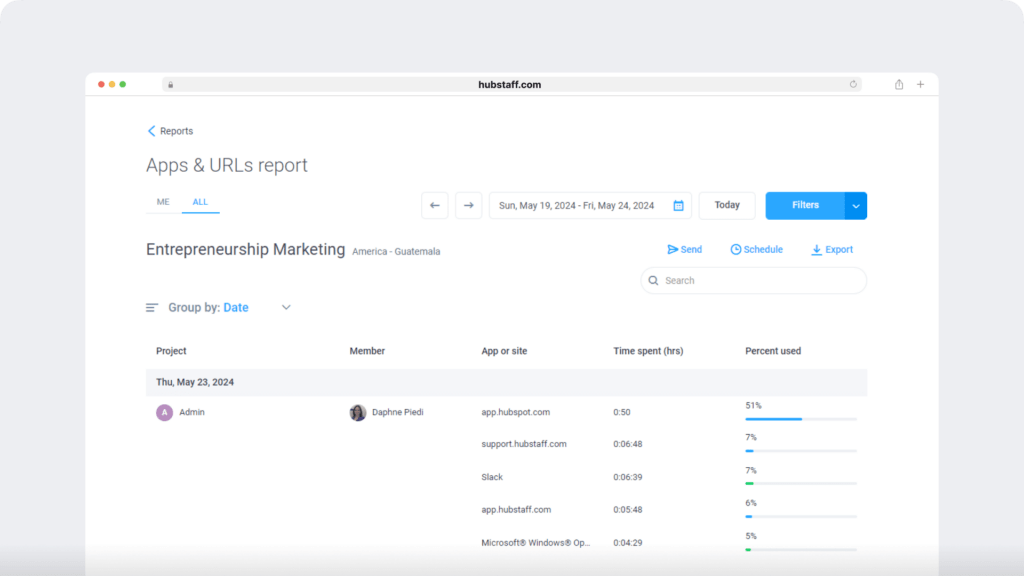
2) The Time Doctor approach
A. Screenshots
The screenshot feature is available in Time Doctor as well, and the default value is one screenshot every three minutes. This can be changed by the manager to a time frame that is convenient.
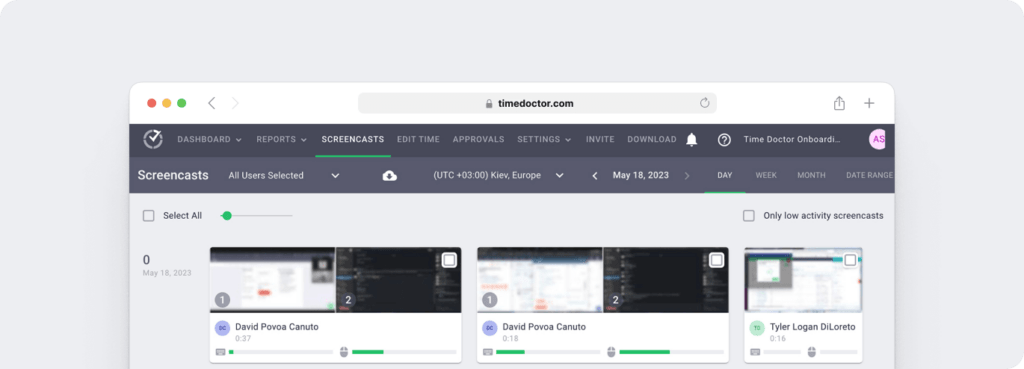
Time Doctor has screenshots as an optional feature — managers can enable or disable it for each employee.
Besides helping monitor remote employees effectively, the screenshots feature can also come in handy in specific types of companies, such as design shops, which can use them to review work processes and improve productivity.
Note: In Time Doctor, screenshots are only taken when team members indicate that they’re working and not during breaks. Moreover, screenshots can be deleted by team members, which helps maintain their privacy. However, if any screenshots are deleted, the associated work time is also deducted from their work hours.
B. Web and app tracking
This is how the Web and App usage report from Time Doctor looks like:
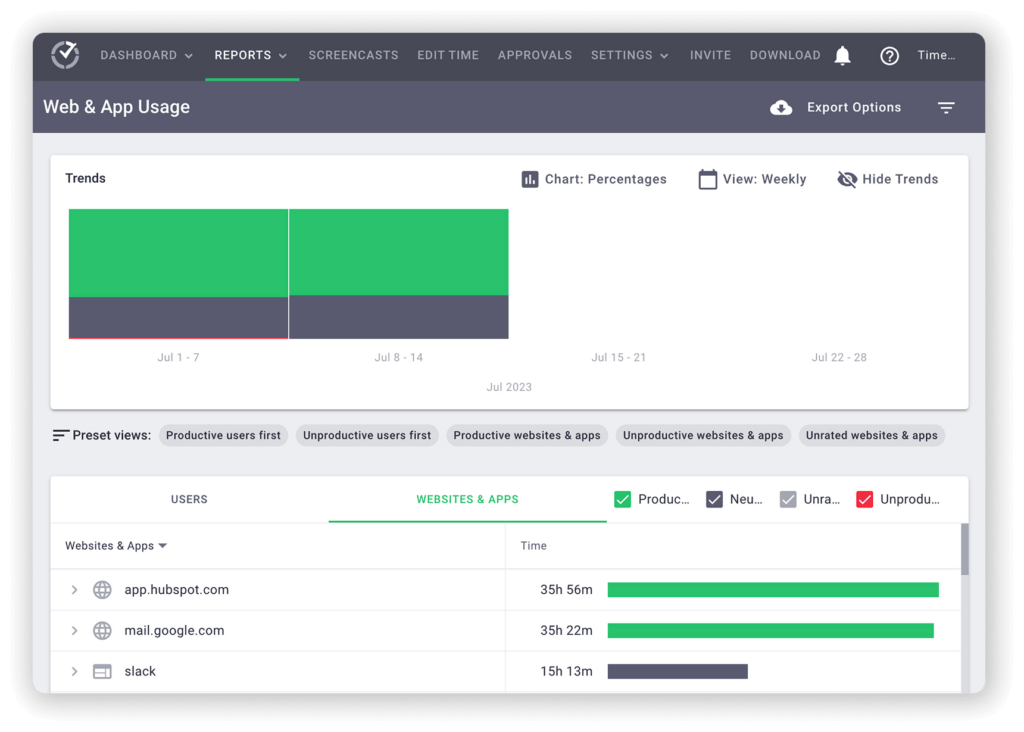
As you can see both websites and applications on a single screen, it’s much easier to see where your employees are spending the maximum time, which means chances to increase productive time and eventually… more money.
Quick recap
Both apps use screenshots as well as website and application monitoring to track employee behavior online. Time Doctor does a better job of presenting the data so that managers can make informed decisions quickly and effectively.
3. Distraction management
We all get distracted at our workplace, whether it’s a Facebook notification or the latest series you’re binge-watching on Netflix.
But that is valuable time lost, and we need someone to nudge us in the right direction.
1) The Time Doctor approach
This is where Time Doctor scores big time.
When it detects excessive usage of Facebook, YouTube, or other personal sites, a small pop-up appears on the screen asking the employee if they’re still working.
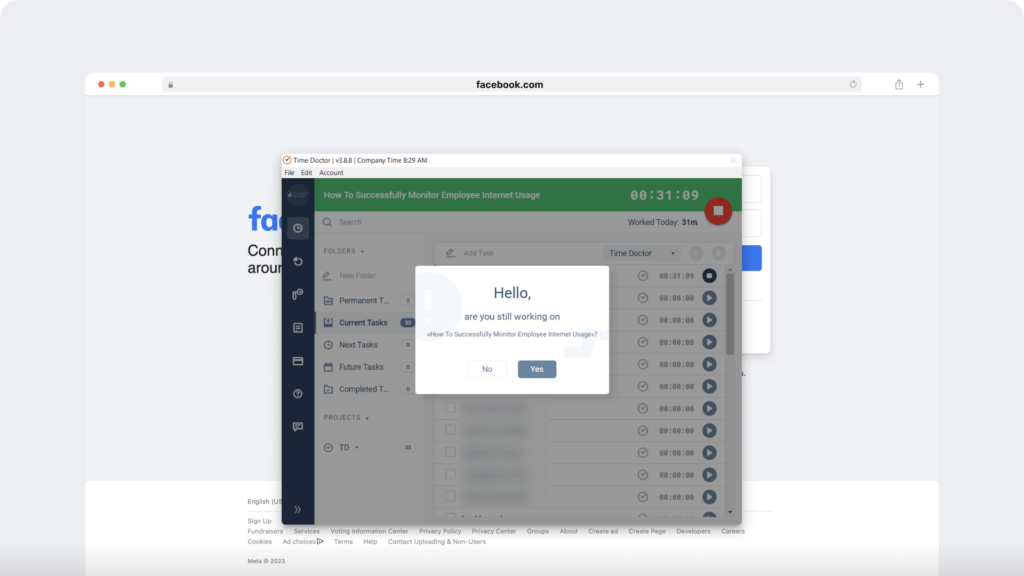
Distraction management as a feature is quite handy since it instills productivity and makes sure your employees are not getting sidetracked.
2) The Hubstaff approach
Sadly, Hubstaff doesn’t have a comparable feature to stop employees from loitering around when they’re supposed to be working. While Hubstaff may give you reports as to excessive time spent on a website or an app, time once lost is lost forever.
Quick recap
Time Doctor is the clear winner in this category because it encourages employees to get back to work in real time. Hubstaff doesn’t have this feature and just gives reports and data, which you have to interpret to tell whether employees have been using time productively. When you look at its practical implications, Time Doctor’s distraction management feature works more effectively in improving productivity.
4. Employee privacy
Tracking your time and letting your computer be monitored by an outside tool while working may sound a bit like an invasion of employee privacy, a grey area that most employers want to stay out of.
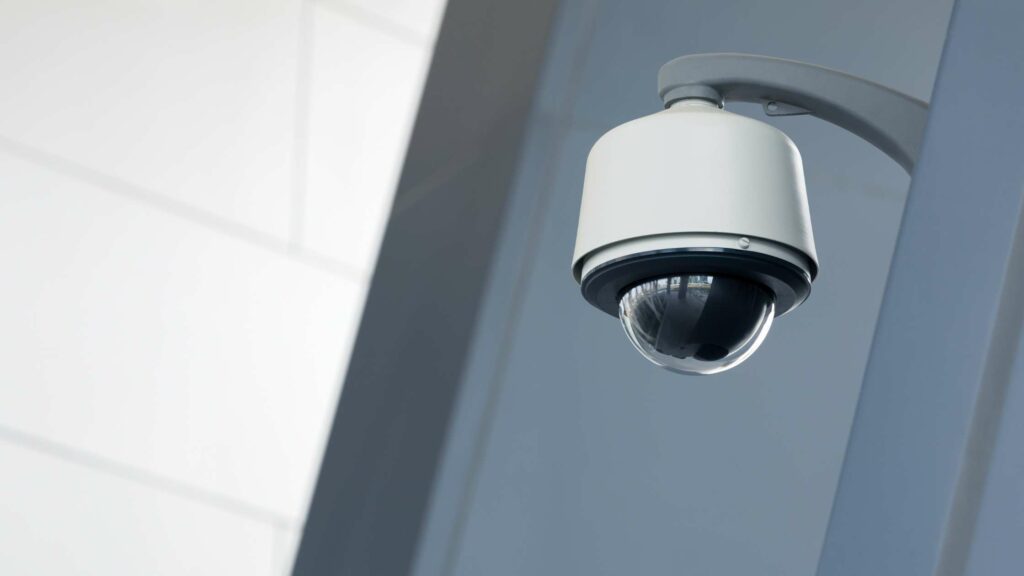
1) The Hubstaff approach
While monitoring employee activity via keystrokes and mouse movements, Hubstaff does not record keystrokes but merely assigns a value (true or false) to any key that was actually pressed.
Hubstaff has the optional function of taking screenshots of employees’ screens when they’re working. Hubstaff stores its screenshots on Amazon’s S3 Servers for additional security.
2) The Time Doctor approach
Time Doctor also clarifies that it only checks if a key was pressed during the time the employee was working and does not keep a record of which key was pressed.
Time Doctor also has the optional functionality of taking screenshots of employees as they’re working.
But unlike Hubstaff, Time Doctor stores your screenshots on servers with which communication is secured – via SSL encryption. These servers are located in secure data centers with 24/7 monitoring support.
No third party can access your screenshots.
Quick recap
Both Hubstaff and Time Doctor monitor your keyboard and mouse activity, but don’t do “keyboard logging.” Both the tools also take screenshots of your team during their working hours and store them for a specified amount of time. Your employees should be made aware that their activity is being monitored during the day.
The big question is: Do you want to share your screens with a third party (Hubstaff) or keep it in a secure private server (Time Doctor)? Your call.
5. Reports and timesheets
Tracking employee time, making sure they’re not getting distracted, and employee activity monitoring is all fine, but how do you analyze productivity?
Do you take detailed notes and then pull up your trusty old spreadsheet, typing away days of data, making sure it’s accurate, and hoping you haven’t fallen asleep at the keyboard.
Sounds very interesting, right?
What if we told you there was an easier method?
These tools come bundled with a reports feature that makes your life that much easier.
1) The Hubstaff approach
Hubstaff, for instance, has a separate reports section, where you get detailed reports which look like this:
The reports are divided into six categories:
1. General reports
Under general reports, you can generate six reports:
- Weekly report: Displays the same information as the Time and Activity Report but for the entire week.
- Manual time edits: This report shows the modifications made on the activities recorded on your account or organization, for example, if an employee made changes to their tracked time.
- Expenses: This report makes expense tracking easy – showing expense data by date and time.
- Timesheet approval: Displays an overview of timesheet data.
- Apps and URLs: A report of the apps and URLs visited and how much time your team spent on them.
- Time and activity report: It details the total time tracked, activity percentages, spent amounts, and billable amounts by any user for a project or task.

2. Payment reports
There are two categories of payment reports:
- Accounts Owed: Displays the time marked as unpaid within the organization.
- Payments: Shows a list of payments made by the organization.
3. Budgets and limits
There are four reports that fall under this category to help with budgeting:
- Weekly limits: This report displays the weekly limits set for each team member. It also shows time spent working and remaining time for the week.
- Project budgets: Shows the budget for each project and the time spent on each.
- Client budgets: This report shows budgets for all projects associated with a particular client and the time spent on each.
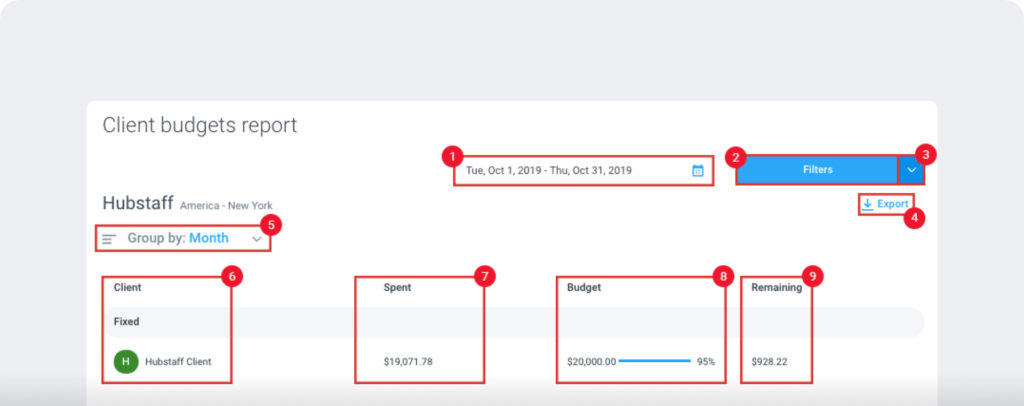
4. Time-off reports
There are two reports that can be generated under this category:
- Time-off balance: Shows the available, used, and pending time-off balances of team members.
- Time-off transactions: Displays all approved time-off balances.
5. Attendance report
The Attendance Report helps employers manage their organization’s schedule.
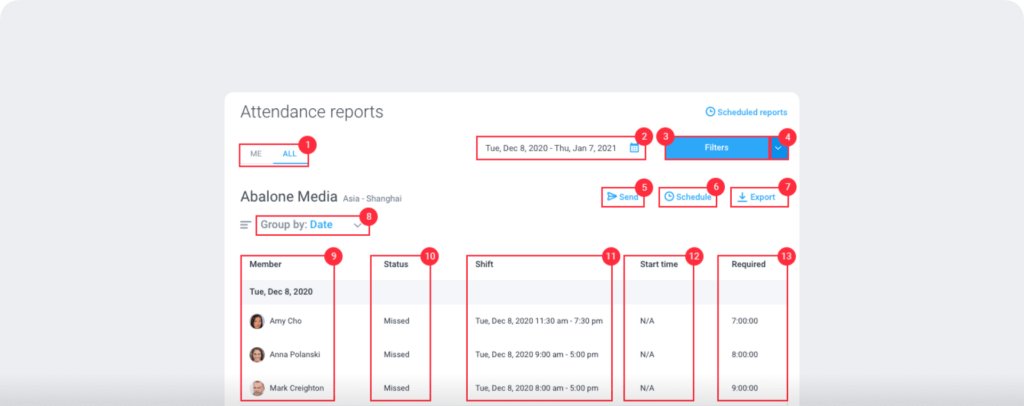
6. Job sites report
It displays all tracked time by each team member for a specific job site. This report is only available for premium plans.
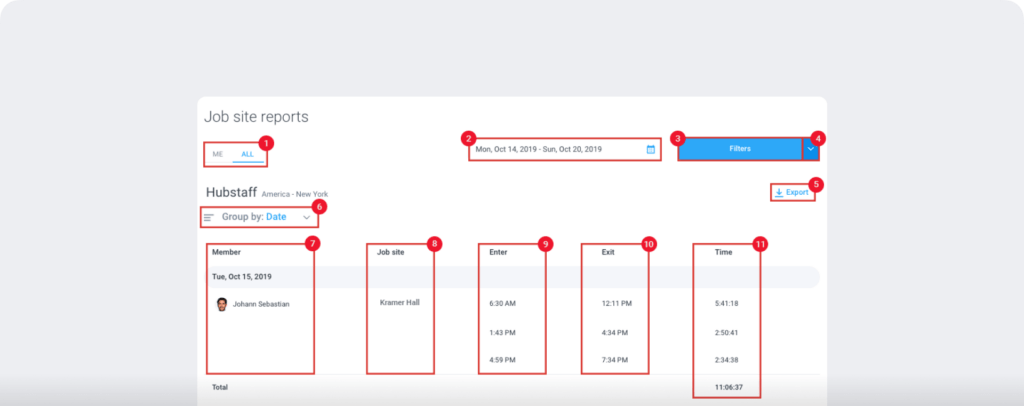
Hubstaff lets you send these reports by email to members outside the organization, download them as a PDF or a CSV file so that you can view them offline to plan and review your team’s workflow as you wish.
2) The Time Doctor approach
Not one to be left behind, Time Doctor also gives you several options to generate comprehensive reports.
So what are these impressive reports that Time Doctor generates?
Well, there are eight different types, and here’s a quick lowdown on each of them.
1. Dashboard
Shows a user’s current status, the total worked for the day (or week), and the times they worked. You can also hover over the timeline to see which tasks were being worked on and for how long.
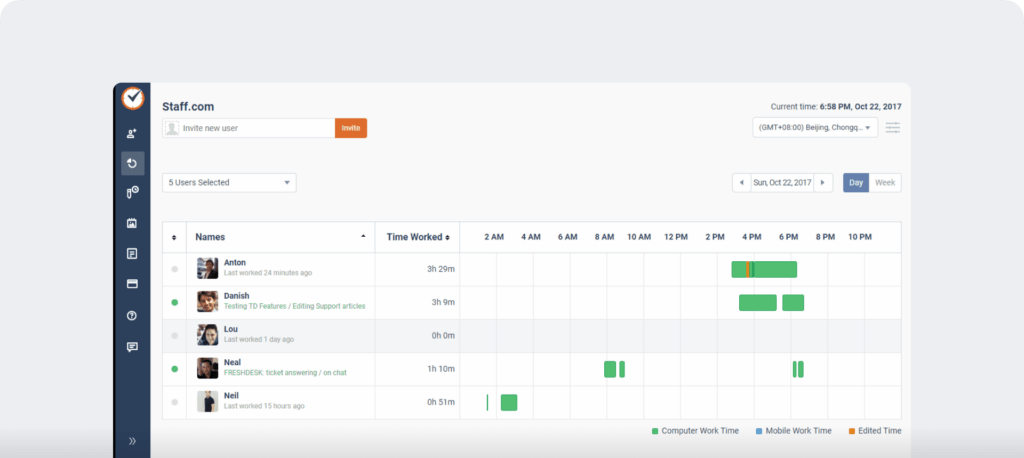
2. Timesheet report
Shows you the total amount of accountable time for a particular user for that day (or week).
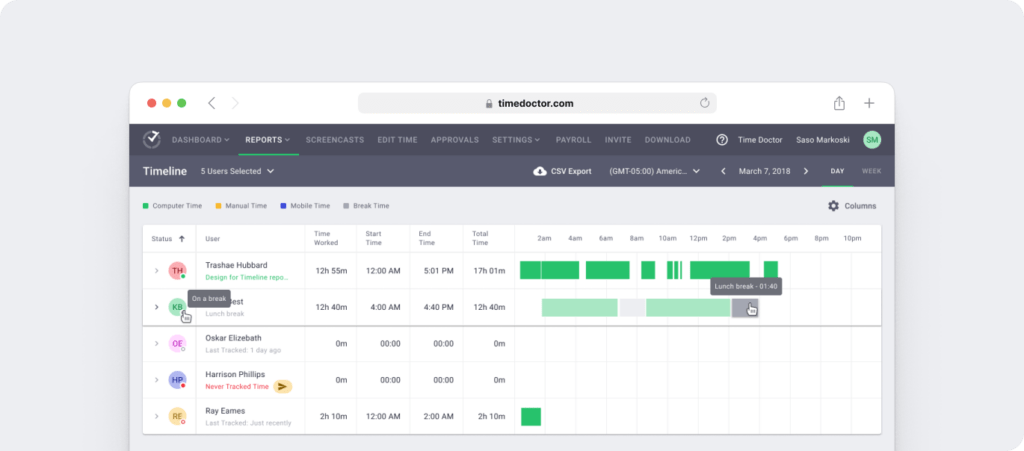
3. Time use report
Shows the total time worked for one or more users and how many hours they have spent on each task.
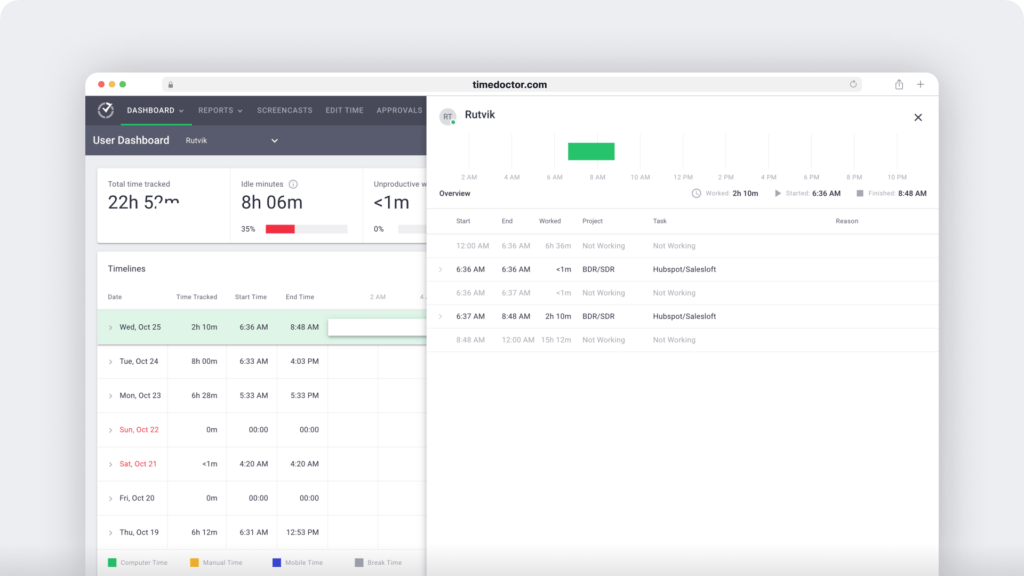
4. Timeline report
This is a useful task management tool, showing the activity for different users for the chosen day.
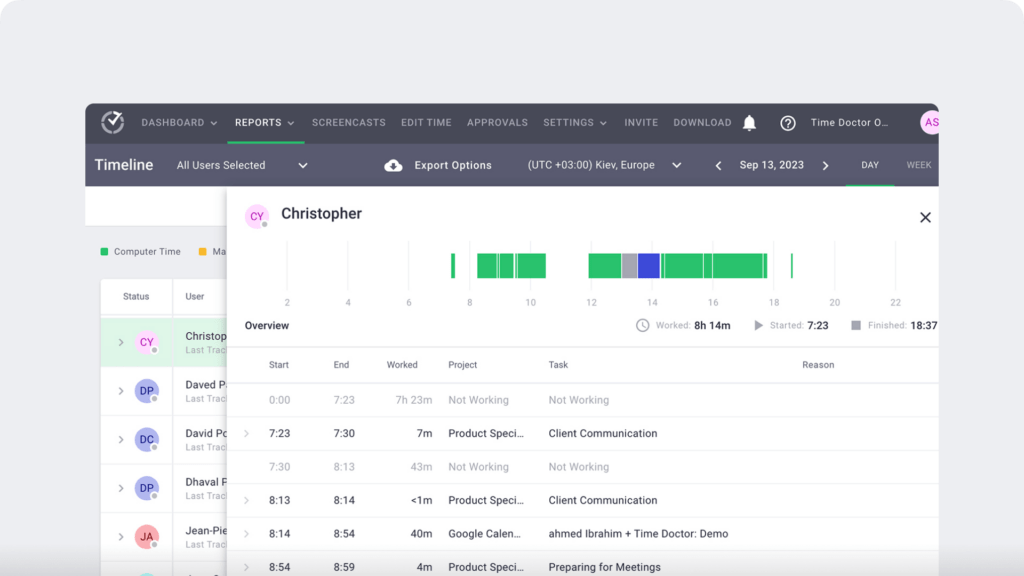
5. Poor time use report
This is a report which shows the amount of time different users spend on websites that are not work-related, such as social media sites or YouTube.
6. Web and app use report
Shows a list of applications or websites which you or your team used while working.
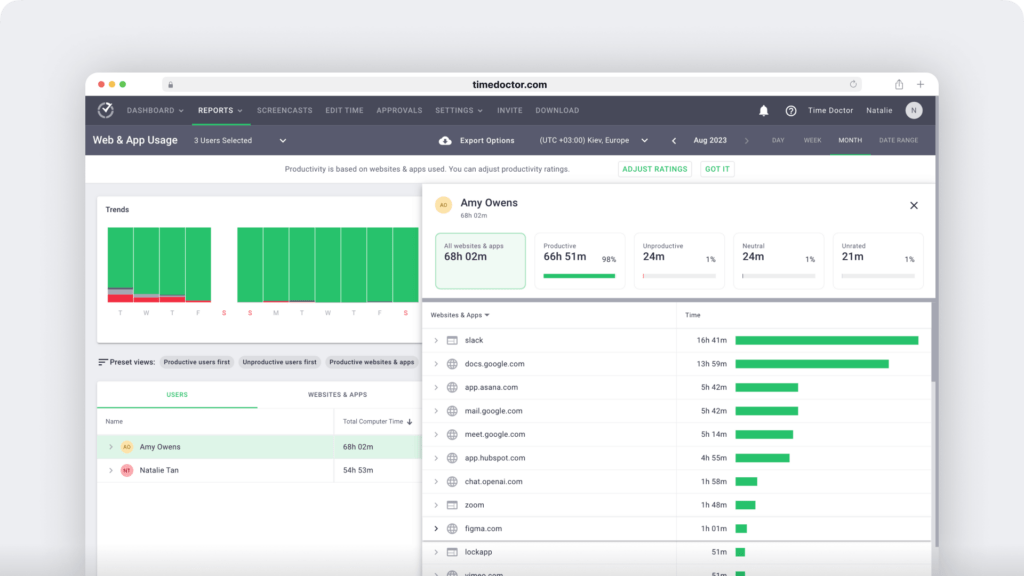
7. Projects report
A useful project management report that shows how much time was spent on different projects and by which team members.
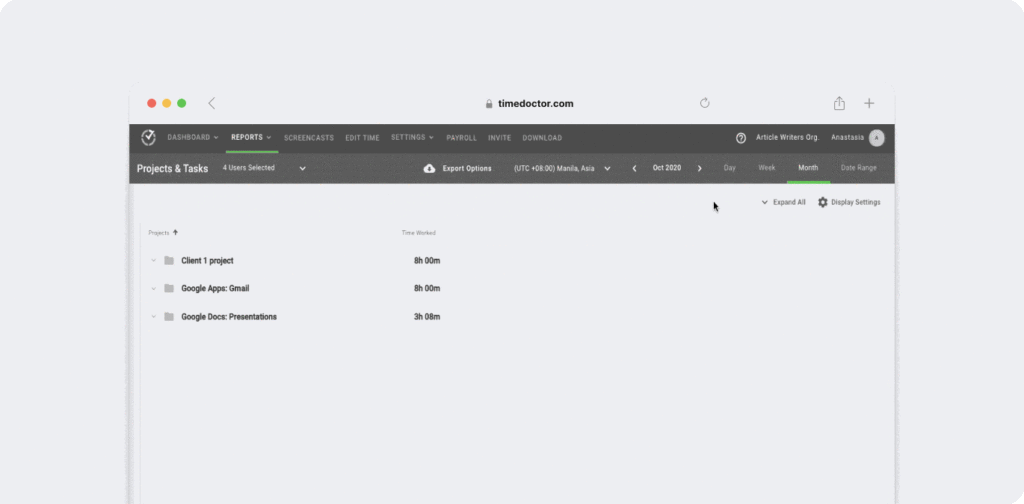
8. Attendance report
A good old way of showing who was not present or was late to their scheduled working hours.
Users can also add why they were absent, such as an appointment at the eye doctor for staring at the screen for too long, etc.
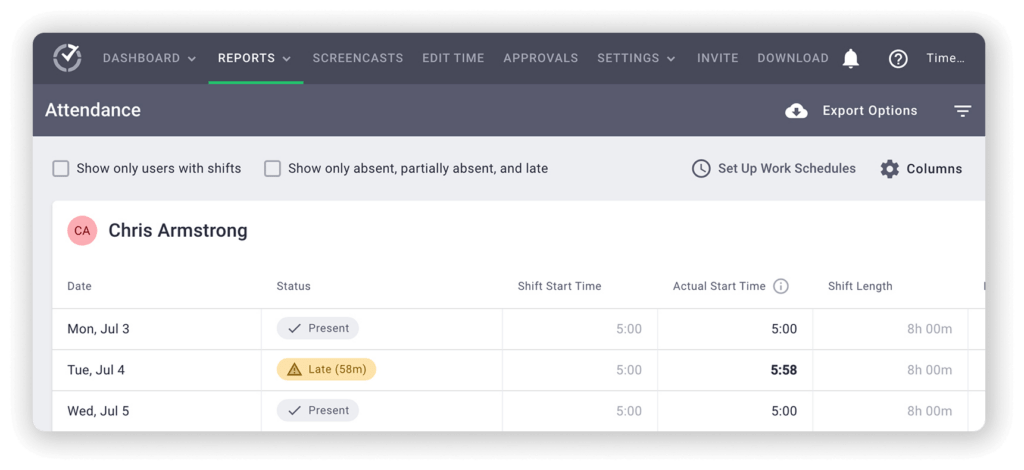
Most of the reports are downloadable as PDF or CSV files, so that you can access them offline.
Quick recap
Both tools generate different sets of reports that give a manager or an employee the ability to track their productivity and improve wherever possible.
Hubstaff takes a more conventional approach. Although they’re quite comprehensive, the Hubstaff reports lack the versatility that some of the Time Doctor reports provide.
For instance, Time Doctor’s Poor Time Use report is highly effective in understanding which non-work related websites or apps are taking up an employee’s time. This can enable managers to get to the underlying reason for wasted time and discuss with team members to find a solution.
6. Payroll and invoicing
The main purpose of these two tools is to increase employee productivity and streamline various business activities – saving time and ultimately making the business more profitable.
One such time-consuming activity is financial management.
Which is ironic because time is money, right?
The more time you spend on managing money, the less money you make!
So how do these tools help ease the burden of invoicing payroll and invoicing within the company?
1) The Hubstaff approach
Hubstaff offers an automatic payroll feature to save you the time of manually calculating each employees’ hours and pay. It also offers an automatic invoicing feature to ensure accurate billing.
Here’s what you should keep in mind:
- Hubstaff allows you to sync timesheets with your payroll. If your employees are paid by the hour, the fact that the time cards are accurate means your payroll will be too.
- Integration with Quickbooks is also possible to automatically export time tracked.
- Payment gateways Hubstaff can connect to include PayPal, Wise, formerly Transferwise, and Payoneer.

2) The Time Doctor approach
Generating payroll with Time Doctor is simple.
Thankfully, you won’t have to rely on Excel formulas anymore when processing payroll.
With Time Doctor’s payroll feature, you can:
- Create automated timesheets that can be used to make batch payments.
- Set automated pay periods and currencies for employees and contractors in other countries.
- Set up payroll for employees who are paid hourly and team members who receive a set salary.
- Integrate your payroll with payment gateways like PayPal, Payoneer, Gusto, ADP, and Wise, formerly TransferWise.
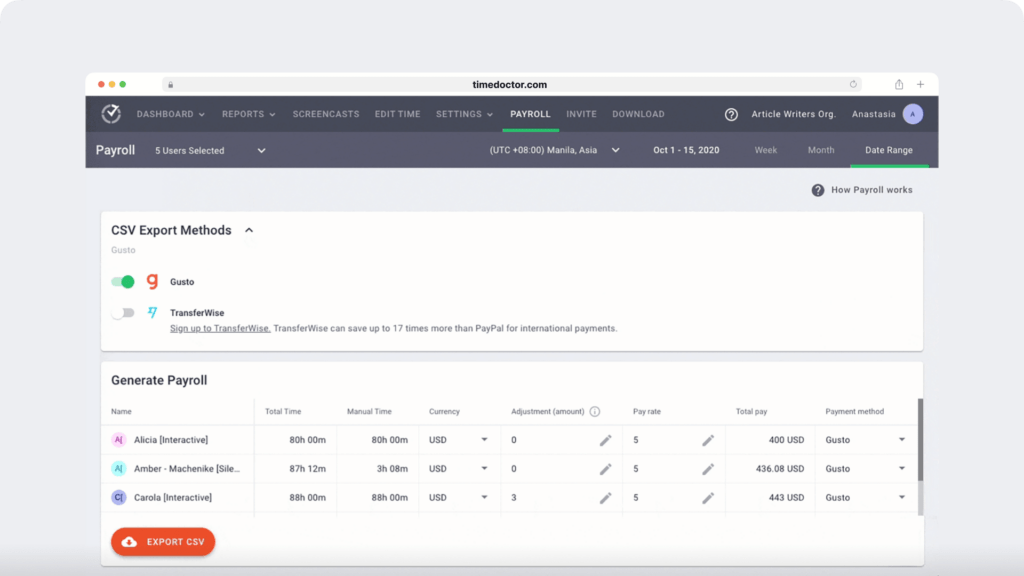
Quick recap
Both tools offer an automated payroll option based on timesheets and an automated invoicing option based on billable hours. They also offer integration with payment gateways you may already be using, such as PayPal.
7. Pricing
Coming to the big question. How much are these tools going to cost?
Can you still run a profitable business managing a remote team?
Let’s start with Hubstaff.
1) Hubstaff pricing plans
There are four different plans that Hubstaff provides to all its users:
Free plan: Gives you basic time tracking and activity levels. However, it only supports one user. Go for it if you just want to take the tool out for a spin to see what it feels like.
- Basic plan: Starts at $7/user per month and offers very limited functionality. So if you want to monitor your employees with GPS tracking, this isn’t the option for you.
- Premium plan: Priced at $10/user per month – includes “Basic” features + GPS and mobile tracking + time off and holidays + attendance monitoring + payroll.
- Enterprise plan: Starts at $20/user per month – includes “Premium” features + VIP support + concierge account set-up + higher public API limits.
Hubstaff also offers a 14-day free trial on all paid plans.
2) Time Doctor pricing plans
Time Doctor keeps it simple again with options.
Let’s take a look at the pricing plans:
- Basic: $7/user per month – offers time tracking + task management + unlimited screenshots + activity tracking.
- Standard: $10/user per month – includes “Basic” features + payroll + integrations.
- Premium: $20/user per month – includes “Standard” features + client login access + concierge account setup.
Everything the software offers, you can try free for 14 days (without a credit card).
Quick recap
While Hubstaff offers you versatility with its different plans, the features it provides in its lower variants don’t exactly do justice to its long list of capabilities.
Time Doctor, on the other hand, takes a no-nonsense approach to its pricing, so you know that when you pay, you get a chance to glimpse everything the tool offers.
8. Software setup
We are almost at the end of this battle royale, where both these tools have tried to beat each other up with similar features and competitive pricing.
So in this section, we are comparing the two tools based on their ease of use.
1) The Hubstaff approach
The setup of Hubstaff is pretty straightforward.
Your manager/employer sends you an invitation to join Hubstaff, and you just have to accept it.
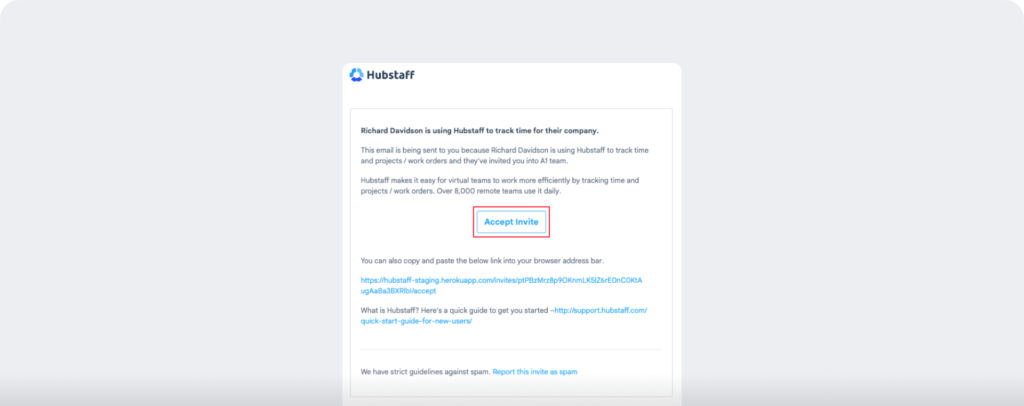
Enter a few more details like your name and email address and confirm this email.
You’ll need to download the desktop client by clicking on your avatar. It can be found on the bottom left-hand side of your web dashboard. See below:

Download the Hubstaff tool, select your operating system (Hubstaff supports Mac, Linux, and Windows) and run the installation.
Once complete, log in with your credentials, and you can see a list of projects that your manager has assigned to you. You can click on any project that you wish to start, and boom, you are good to go.
While it’s compatible with Android and iOS devices, the mobile app has very limited functionality — for example, it lacks web and app usage tracking features.
2) The Time Doctor approach
Is Time Doctor as easy to set up? You bet it is.
Just download the Time Doctor app from the website.
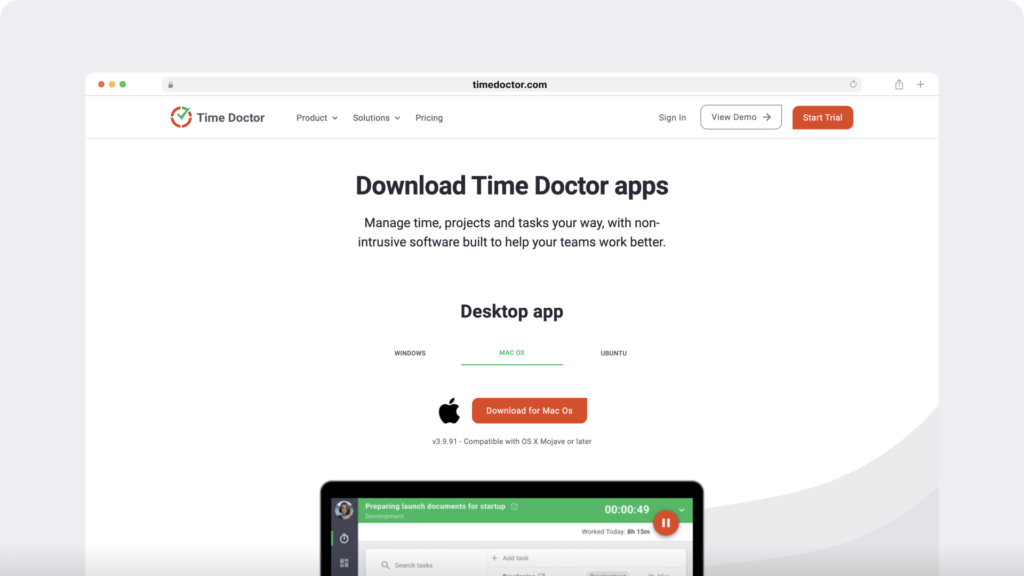
Run the installer, enter your email address and password when prompted, and you can use Time Doctor to monitor your productivity. That’s it!
Time Doctor is compatible with all devices — Windows, Max, Linux, iOS, Android, and even has a Chrome extension.
Quick recap
Both the tools are relatively easy to set up.
Where Time Doctor wins is that it lets you directly download the tool from its website, whereas Hubstaff asks you for your email and login credentials or needs to have an invite sent by your employer. Both tools have video tutorials available to help guide you through the process.
You may also want to check out our list of the best Hubstaff alternatives.
Hubstaff vs Time Doctor: Final verdict
Although on the surface, both tools look similar and perform the same function, when you dig deeper, it’s evident that Time Doctor beats Hubstaff in most categories.
Better UI, more comprehensive reports, better distraction management, clearer pricing, and ease of setup, Time Doctor wins because it pays attention to all the small details.
We hope we were able to help you choose a suitable tool to improve your team’s productivity. So why not sign up for a free trial of Time Doctor today?


